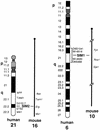Cloning of two human homologs of the Drosophila single-minded gene SIM1 on chromosome 6q and SIM2 on 21q within the Down syndrome chromosomal region
- PMID: 9199934
- PMCID: PMC310662
- DOI: 10.1101/gr.7.6.615
Cloning of two human homologs of the Drosophila single-minded gene SIM1 on chromosome 6q and SIM2 on 21q within the Down syndrome chromosomal region
Abstract
As part of our effort to clone genes of human chromosome 21 that may contribute to Down syndrome, we have previously isolated four exons with homology to Drosophila single-minded (sim) gene, which encodes a transcription factor that is a master regulator of fruit fly neurogenesis. These exons were used to clone and characterize two human homologs of the Drosophila sim gene, SIM1 and SIM2, which map to chromosomes 6q16.3-q21 and 21q22.2, respectively; SIM2 maps within the so-called Down syndrome chromosomal region. Recently, two mouse homologs, Sim1 and Sim2, also have been identified. There is a high level of homology among human, mouse, and Drosophila sim genes in their amino-terminal half where the conserved bHLH, PAS1, PAS2, and HST domains are present. In contrast, the carboxy-terminal parts are only homologous between SIM1 and Sim1 and SIM2 and Sim2. Two isoforms (SIM2 and SIM2s) of human SIM2 have been detected that differ in their 3' ends. Northern blot analysis revealed one mRNA SIM1 species of approximately 9.5 kb and four different mRNA SIM2 species of 2.7, 3, 4.4, and 6 kb in human fetal kidney. The function of both human SIM1 and SIM2 is unknown. However, three copies of SIM2 may contribute to some specific Down syndrome phenotypes because of (1) mapping position, (2) potential function as transcriptional repressor, (3) likely dimerization with other transcription factors, (4) the temporal and spatial expression pattern of mouse Sim2, and (5) the potentially analogous role of human SIM2 to that of Drosophila sim during neurogenesis.
Figures





References
-
- Altschul SF, Gish W, Miller W, Myers EW, Lipman DJ. Basic local alignment search tool. J Mol Biol. 1990;215:403–410. - PubMed
-
- Asakawa, S., I. Abe, Y. Kudoh, N. Kishi, Y. Wang, R. Kubota, J. Kodoh, K. Kawasaki, S. Minoshima, and N. Shimizu. 1997. Human BAC library: Construction and rapid screening. Gene (in press). - PubMed
-
- Chen H, Chrast R, Rossier C, Gos A, Antonarakis SE, Kudoh J, Yamaki A, Shindoh N, Maeda H, Minoshima S, Shimizu N. Single-minded and Down syndrome? Nature Genet. 1995;10:9–10. - PubMed
-
- Chen H, Chrast R, Rossier C, Morris MA, Lalioti MD, Antonarakis SE. Cloning of 559 potential exons of genes of human chromosome 21 by exon trapping. Genome Res. 1996;6:747–760. - PubMed
-
- Crews ST, Thomas JB, Goodman CS. The drosophila single-minded gene encodes a nuclear protein with sequence similarity to the per gene product. Cell. 1988;52:143–151. - PubMed
Publication types
MeSH terms
Substances
Associated data
- Actions
- Actions
- Actions
- Actions
LinkOut - more resources
Full Text Sources
Other Literature Sources
Medical
Molecular Biology Databases
Research Materials
